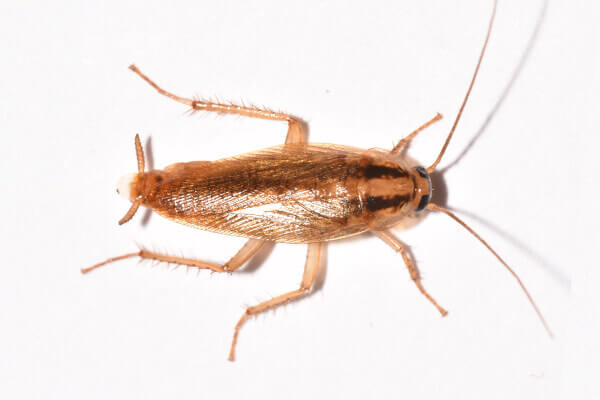German Cockroach Facts & Information
Everything you need to know about the German cockroach
what do German Cockroaches look like

Talk about an unpleasant surprise. German cockroaches hide in dark places like refrigerator motor housing, behind dishwashers, and inside cabinets only to crawl out when you least expect it. Their long, flat bodies allow them to squeeze into food containers and slip through tiny cracks with ease. German cockroaches are light brown to tan with two dark “racing stripes” on their backs. They have 6 legs, 2 antennae, are oval in shape, and are about 1/2″-5/8″ long. You need a cockroach exterminator if you have seen one.
German cockroaches prefer to live in warm, humid places close to food and moisture sources. They are frequently found in kitchens and bathrooms. You’re also likely to find German cockroach dropping in areas they frequent. Droppings may appear as small, dark, “pepper-like” material left on countertops or in drawers. There may also be fecal staining, which appears as dark spots or smears in the corners of rooms, along the tops of doors or around small cracks and openings into walls. In addition, when German cockroach populations are present in large numbers, it may be possible to detect a mild, somewhat “musty” odor.Not the cockroach you have?
German cockroaches prefer to live in warm, humid places close to food and moisture sources. They are frequently found in kitchens and bathrooms. You’re also likely to find German cockroach dropping in areas they frequent. Droppings may appear as small, dark, “pepper-like” material left on countertops or in drawers. There may also be fecal staining, which appears as dark spots or smears in the corners of rooms, along the tops of doors or around small cracks and openings into walls. In addition, when German cockroach populations are present in large numbers, it may be possible to detect a mild, somewhat “musty” odor.Not the cockroach you have?
how did i get german cockroaches
German cockroaches usually prefer a moist environment with a relatively high degree of warmth. German cockroaches show a preference for warm (70°F/21°C) and humid places. Even though they are usually found in residential and commercial kitchens and secondarily in bathrooms, a German cockroach infestation can occur in any area where people eat and drink. This includes dining rooms, living rooms, dens, and bedrooms. Any crack of crevice located near a source of food and/or water can harbor cockroaches. German cockroaches can fit through an opening as small as 3/8 inch in width. The insects are mostly scavengers and will feed on a wide variety of foods. They are especially fond of starches, sweets, grease, and meat products. In many locations, garbage is a principal food source. As with other species, German cockroaches are mostly active at night, when they forage for food, water, and mates. During the day they hide in cracks and crevices and other dark sites that provide a warm and humid environment. Their relatively wide, flat bodies enable them to move in and out of cracks and narrow openings with ease. They may be seen during the daytime, particularly if a heavy population is present or if there is some other stress, such as a lack of food or water or an application of DIY products.
German cockroaches produce a larger number of eggs per capsule and they undergo the shortest time from hatching until sexual maturity, resulting in a rapid population growth. A greater number of nymphs hatch successfully because the female carries the egg capsule during the entire time the embryos are developing within the eggs. Also, and most importantly, German cockroaches are smaller than most other cockroaches and can conceal themselves in many places inaccessible to individuals of the larger species.
German cockroaches produce a larger number of eggs per capsule and they undergo the shortest time from hatching until sexual maturity, resulting in a rapid population growth. A greater number of nymphs hatch successfully because the female carries the egg capsule during the entire time the embryos are developing within the eggs. Also, and most importantly, German cockroaches are smaller than most other cockroaches and can conceal themselves in many places inaccessible to individuals of the larger species.
what Problems do german cockroaches cause
German cockroaches are more than just a nuisance. They have been associated with outbreaks of illness and allergic reactions. Cockroaches spread at least 33 kinds of bacteria, 7 kinds of human pathogens, and 6 kinds of parasitic worms. As they walk, they pick up disease organisms from decaying matter on the spines of their legs and bodies, transferring them onto food, countertops, cabinets, and anywhere else they walk. They can multiply quickly so make sure you call a professional to provide cockroach treatment for final roach control.
German cockroaches produce odorous secretions that can affect the flavor of various foods. When cockroach populations are high, these secretions may result in a characteristic odor in the general region of the infestation. Disease-producing organisms such as bacteria, protozoans, and viruses have been found on cockroach bodies. Different forms of gastroenteritis (food poisoning, dysentery, diarrhea, and other illnesses) are the principal diseases transmitted by German cockroaches. The organisms causing these diseases are carried on the legs and bodies of cockroaches and are deposited on food and utensils as the cockroaches forage. Cockroach excrement and cast skins also contain a number of allergens to which many people exhibit allergic responses, such as skin rashes, watery eyes and sneezing, congestion of nasal passages, and asthma.
German cockroaches produce odorous secretions that can affect the flavor of various foods. When cockroach populations are high, these secretions may result in a characteristic odor in the general region of the infestation. Disease-producing organisms such as bacteria, protozoans, and viruses have been found on cockroach bodies. Different forms of gastroenteritis (food poisoning, dysentery, diarrhea, and other illnesses) are the principal diseases transmitted by German cockroaches. The organisms causing these diseases are carried on the legs and bodies of cockroaches and are deposited on food and utensils as the cockroaches forage. Cockroach excrement and cast skins also contain a number of allergens to which many people exhibit allergic responses, such as skin rashes, watery eyes and sneezing, congestion of nasal passages, and asthma.
how can i prevent german cockroaches
The best advice for German cockroach control is to practice good sanitation. To prevent German cockroaches from infesting your home be sure to maintain a clean kitchen by cleaning up crumbs, wiping spills, and vacuuming often. Avoid allowing dishes to pile up in the sink. It’s also important to seal all entrances to your home, especially around utility pipes, and ventilate crawl spaces to prevent moisture buildup. A moisture barrier can also help with that and professional exclusion services can help with sealing cracks and crevices.
WHY WESTERN for german cockroaches
We’re passionate about controlling cockroaches in your home or business because we live and work here – it’s our neighborhood, too. With our almost 100 years of experience keeping homes and businesses in Connecticut, Delaware, New Jersey, New York, and Pennsylvania safe from pests, Western has the experience you can trust.
100% Satisfaction Guarantee
24-Hour Guaranteed Response
Board Certified Entomologists
Need help with German cockroaches?
GET MY QUOTE
